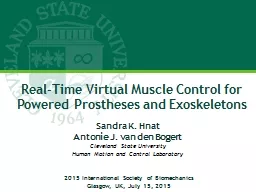

Sandra K Hnat Antonie J van den Bogert Cleveland State University Human Motion and Control Laboratory 2015 International Society of Biomechanics Glasgow UK July 15 2015 I ntroduction ID: 931310
Download Presentation The PPT/PDF document "Real-Time Virtual Muscle Control for Pow..." is the property of its rightful owner. Permission is granted to download and print the materials on this web site for personal, non-commercial use only, and to display it on your personal computer provided you do not modify the materials and that you retain all copyright notices contained in the materials. By downloading content from our website, you accept the terms of this agreement.
Slide1
Real-Time Virtual Muscle Control for Powered Prostheses and Exoskeletons
Sandra K. Hnat
Antonie
J. van den
Bogert
Cleveland State University
Human Motion and Control Laboratory
2015 International Society of Biomechanics
Glasgow, UK, July 15, 2015
Slide2I
ntroduction
1/11
Current Prostheses
Semi-active controller
Active controller
Virtual Muscle Control
Potential for a biological control system
Based on the human actuation system
Gerritsen
KG, et al., Motor Control, 1998.
-controlled damper
-torque motors
-muscle dynamics are more stable
Add muscle advantages into prostheses
Slide3I
ntroduction
2/11
Objectives
Create a virtual muscle model that
outputs torque given muscle excitation
1
Obtain accurate results with minimal computation time
2
Simulate open-loop muscle control
v
s. open-loop joint torque control
3
Slide4M
ethods:
model
Planar Leg Model
3/11
6 muscles
-3 joint angles (
q
)
-6 muscle excitations (
u
)
Monoarticular
Biarticular
Vasti
Rectus
Femoris
Soleus
Hamstrings
Tibialis
Anterior
Gastrocnemius
Inputs
Outputs
-joint torque (
) of knee and ankle
Slide54/11
M
ethods:
control diagram
Slide65/11
M
ethods:
hill muscle model
Contractile Element
-standard force-length
-standard force-velocity
Series/Parallel Elastic Elements
-nonlinear springs
Parallel Damping
-adds numerical stability
Slide76/11
M
ethods:
simulation
Simulated with first order implicit
Rosenbrock
solver
van den
Bogert
AJ
, et al.,
Procedia
IUTAM
2011.
Fixed time step solver
-required for real-time simulation
Dynamic Model
-simulation vs. accuracy will be tested
Slide87
/11
M
ethods:
open-loop simulation
Three-Link Pendulum Model
Control Comparison
Knee and ankle torque used as input
Passive hip (no torque)
Case 2:
Muscle control uses the angles of the pendulum as input
Muscle excitation (u) as
sinewaves
with 1 Hz frequency
Case 1:
Open-loop torque obtained from output of muscle dynamics
Slide98/11
R
esults:
model response
Slide109/11
R
esults:
Speed and accuracy
r
eal-time
r
eal-time
Slide1110/11
R
esults:
open-loop simulation
Open-Loop
Torque Control
Open-Loop
Muscle Control
Slide1211/11
C
onclusion
Future Work
Objectives
Create a virtual muscle model that
outputs
torque given muscle activation
Obtain accurate results with minimal computation time
Simulate
open-loop muscle control vs. joint
torque control
Slide13A
cknowledgments
Parker Hannifin Human Motion and Control Laboratory
(hmc.csuohio.edu)
Parker Hannifin Graduate Research Fellowship Program
Supported by the National Science Foundation under Grant No. 1344954.
Slide14S
upplementary